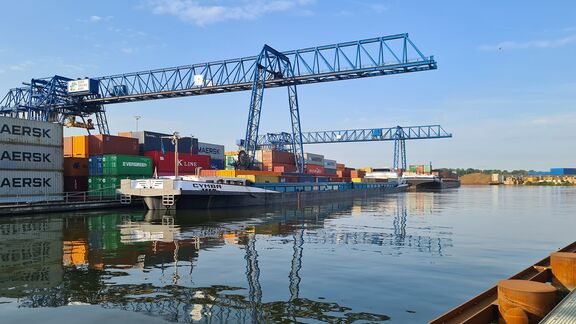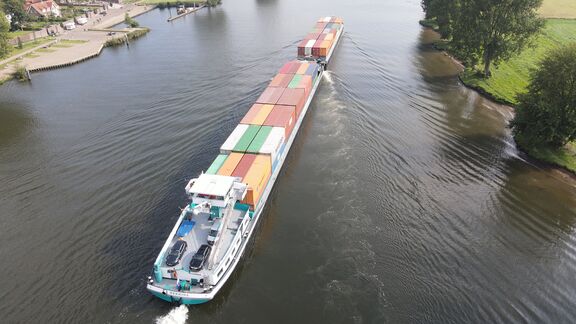'On water if possible, on the road if necessary'
Reading time: 8 minutes
Inland waterway transport is sustainable and efficient. The Port of Rotterdam Authority supports the collaboration in various corridors between inland shipping operators, deep-sea and inland terminals regarding the bundling of containers. For years, there has been a collaboration with parties in the Province of Limburg for making multimodal transportation between the city of Rotterdam and the province of Limburg more attractive to shippers, logistics service providers and shipping companies.
What have been the developments around the ‘inland corridor’ between Rotterdam and Limburg? We interviewed Zelissen Logistics & Services, Barge Terminal Born and Supply Chain Valley with this question.

Download the infographic
For the last two years, Zelissen Logistics & Services has been using inland shipping for a client that moves containers with car parts from China to Limburg through Rotterdam. The Rotterdam World Gateway, Hutchison Ports ECT Delta and ECT Euromax deep-sea terminals are connected to inland terminals in the cities of Venlo and Born four times a week, using inland vessels via the Limburg Express, a collaboration between Hutchison Ports Venlo, Barge Terminal Born and Danser Group. From the Barge Terminal in Born, Zelissen uses trucks to move the containers to its warehouse in Susteren, with its area of 22,000 square metres, which is only a few kilometres away. At this location, a quality check is performed on the freight and further transportation to car manufacturers in Germany and Belgium is prepared.
Major CO2 reduction
‘It involves about 1,000 containers annually that we used to move from Rotterdam to Susteren by truck’, says director Nick Zelissen. Inland transport fits in well with Zelissen’s sustainability strategy, which includes gas-free warehouses, movement-sensor-based LED lighting and waste separation at all of its locations. Calculations according to the GLEC standard (Global Logistics Emissions Council, source: Joint Corridors Off-Road) confirm the sustainable nature of inland waterway container transport.
The trajectory from Rotterdam to Susteren involves 228 km of waterway distance and 4 km of road transport to the end location. With inland waterway transport, total CO2 emissions amount to 60 kg per TEU. CO2 emissions caused by direct road transport between Rotterdam and Susteren (210 km) amount to 200 kg per TEU. In other words, the modal shift to inland shipping leads to a decrease of 140 kg of CO2 per container, no to mention the traffic congestion that is avoided by keeping the truck off the road.
Insight and flexibility
However, it’s not Zelissen Logistics and Services BV itself, but the Chinese client that determines which means of transport are used between Rotterdam and Susteren – a decision that is reviewed every year. ‘In terms of price, transport via inland waterways benefits our client more at this point in time. Our advantage is that we know exactly when the containers arrive once they have been put on the barge in Rotterdam. This is a lot less easy to predict when road transport is involved. Also, we’re able to make solid arrangements with the terminal at Born, where 10 to 30 of our containers usually arrive at the same time. If we have a shortage of certain car parts in our warehouse, we are able to pick up the container that holds those parts from the terminal first, which gives us a lot of flexibility. It also allows us to manage daily loading and handling traffic activity more efficiently. We are very happy about the terminals services.’
Multimodal transport
These are words that Diedrik Ezendam, commercial manager of Barge Terminal Born, likes to hear. In its nearly 35 years of existence, Barge Terminal Born has grown to become one of the Netherlands’ largest inland terminals. Every year, about 140,000 TEU are processed here. ‘Our region has developed into an important logistics hub, with its many distribution centres,’ says Ezendam. ‘Because of our central location, we are also able to offer our services in Germany and the eastern half of Belgium. We have solid connections with both Rotterdam and Antwerp.’
Economic development
Barge Terminal Born is home to both export and import activities. While the main portion of the company´s business consisted of export, nowadays import covers 65% of the total volume. This turnaround was caused by the decrease in industrial production, among other things, in the Netherlands, Germany and Belgium. ‘The manufacturing industry and chemistry sectors are affected by high energy prices,’ says Ezendam. ‘The Sappi paper factory in the town of Lanaken was recently closed, which was one of our main export clients. We prefer sending full containers back to Rotterdam, but more and more empty vessels are underway these days. We are currently also missing the volumes of VDL NedCar, but we are confident that those will be replaced by something else in two years’ time. However, we are hoping that the economy will get a boost at some point.’
Fixed calls
In order to be a reliable partner to it clients, the Barge Terminal Born depends on the smooth handling process of inland vessels at the port of Rotterdam. ‘We are able to make fixed call deals with the deep-sea terminals that have partnered up with the Limburg Express’, says Ezendam. That makes him happy, since inland vessels in the other deep-sea terminals are still forced to wait for three hours on average before they are processed. He does expect the situation to improve over time, because of Nextlogic.

‘That would be desirable, because I see a lot of potential for inland waterway transport. Shipping companies are focussing increasingly on inland terminals. In terms of costs, inland shipping has become much more attractive compared to road transport. European sustainability directives also have a part to play. Many companies prefer having their containers at our terminal than in Rotterdam. We are a lot closer to them in terms of distance, allowing them to serve their warehouse exactly on time. In our region, new ports are being built and existing ports are being expanded, which are positive signs for inland shipping. However, we are dependent on a good infrastructure and we are dealing with maintenance deficits. The lock in Weurt, which is very important to us, still needs a lot of work.’
Awareness
In Limburg, Supply Chain Valley, which represents the interests of the logistics sector, is working on the national vision: Joint Corridors Off-Road. Program Manager Ivo Schepers is encouraging companies to shift their container transport from the road to waterways and railroad traffic. In the past three years, this has led to a modal shift from 370,000 TEU: 30% of that moved to railroad transport, and 70% to waterways. This leads to a decrease in CO2 emissions of about 7,724,639 tonnes.
‘It is not always easy and you have to be very patient’, says Schepers. ‘Because of the extremely low costs for road transport, we have witnessed a recent reversed modal shift, but that is changing. Sustainability awareness is also on the rise – more companies are required to report on the environmental impact of their activities on the basis of the Corporate Sustainability Reporting Directive (CSRD). As long as things are not more expensive than road transport, shippers favour inland waterways transport. Once this is engrained in their processes, they also almost never revert to road transport. For companies looking to make that change, we analyse the volumes that are eligible to be shifted from roads to inland waterways. Next, we will look into who pays what and with whom the power of decision lies: the shipper or the freight forwarder. That is not always clear to everyone.’
Points of view
According to Schepers, not all products can be shifted easily. For the time being, it is not a possibility for reefer traffic. ‘Research is being done into the possible redemption of this modal shift, too. And also, we’re looking into barge transport of household and corporate waste to the incinerators at Rotterdam. Building materials in the Belgian regions of Flanders and Wallonia are also showing potential, and as for agricultural products, we’re already working on sugar beets, while at the same time also considering transporting grain from northern France to Limburg. The advantage of Limburg is its position along the River Rhine, which is increasingly affected by water level fluctuations. We do not have that problem with the Maas. However, we do depend fully on locks that are operational 24 hours a day. That is an area where both the government and the corporate sector have to assume responsibility.’
Government funding
Companies that are shifting their containers from the road to waterways, are eligible for government funding of EUR 11.76 per TEU during the first two years. This support measure is drawing a lot of interest. Schepers: ‘All told, a minimum of 375 TEU has to be shifted annually. However, most of the SME businesses do not reach such volumes. That is an obstacle. However, more and more companies are recognising the efficiency advantages of container transport in barges to the regional terminals. You know exactly when containers will arrive and you can have them transported to your warehouse on demand. This allows you to properly schedule your personnel and optimise your processes. And one has to dare to think forward: eventually, a CO2 subsidy is bound to appear eventually, the roads will be congested and Rijkswaterstaat will be facing an enormous renovation challenge. Moreover, the shortage of truck drivers is growing fast. If you wait too long to take the step towards inland shipping, you will have to get in line again at a later stage. On water if possible, on the road if necessary. It is not a modal shift, but a mind shift.’

Efficient and sustainable
According to business manager Arwen Korteweg of the Port of Rotterdam Authority, the inland corridor between Rotterdam and Limburg is a prime example of efficient and sustainable container transport through inland shipping. ‘The collaboration between the inland terminals at Born and Venlo and the deep-sea terminals in Rotterdam makes transport via this corridor possible for shippers and logistics service providers in Limburg, which also saves costs in terms of CO2 emissions and road traffic kilometres. Zelissen Logistics has found its way to water, and increasingly more shippers and logistics service providers will start using inland shipping in order to make their supply chain more sustainable.’